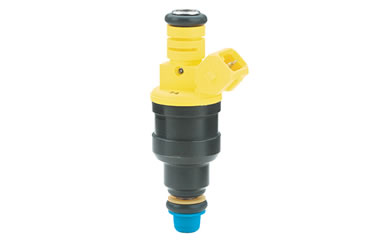This much you know: A) you’ve upgraded your vehicle with a variety of aftermarket mods, and B) you want to get maximum power from those modifications. The question is how to get from point A to point B.
One possible answer is to swap out your stock fuel injectors for larger, higher flowing aftermarket injectors. ACCEL, for example, makes an excellent aftermarket injector that outflows most stock injectors by eight to 14 percent. ACCEL was even nice enough to supply us with information on how to choose the right size fuel injector (ACCEL or otherwise) for your application.
Step 1: Determine Horsepower
You can figure out your horsepower at the crankshaft by having your vehicle dyno tested. ACCEL says you can also make a realistic horsepower estimate by using the manufacturer’s advertised horsepower, plus a conservative estimate of the horsepower gains of any aftermarket modification you may have made.
Step 2: Determine Approximate BSFC (Brake-Specific Fuel Consumption)
Brake-specific fuel consumption, BSFC for short, is the amount of fuel consumed per unit of power produced. You can determine exact BSFC through dyno testing or estimate this figure using the following chart below.
Engine Type BSFC Using Gasoline
High compression 0.45 (no mods) to 0.55 (highly modified)
Super/Turbocharged 0.55 to 0.65 (with modifications)
Step 3: Determine Your Safe Duty Cycle
Duty cycle is the percent of time that the fuel injector is open versus the total time between firing events. The safe duty cycle is 0.80 for most OE engines and 0.85 for modified and road racing engines.
Step 4: Calculate Your Optimum Injector Size
Armed with the information from steps one through three above, you can now calculate the optimum fuel injector size using the following formula:
injector size in lbs./hr. = (Max. HP x BSFC) / (number of injectors x duty cycle)
We’ll use a stock, early-model Ford 5.0L motor with an advertised 215 horsepower for the following example:
(215 x 0.55) / (8 x 0.80) = 18.5 lb./hr.
Now we’ll give the same engine more efficient GT-40 type components that will lower the BSFC and use a more realistic .85 duty cycle limit. According to Ford, these GT-40 parts will raise the horsepower output to 275 horsepower, so we’ll make the following calculations:
(275 x .050) / (8 x 0.85) = 20.1 lbs./hr.
Step 5: Fine-Tune the Flow
Until now, your best option would be to calculate your injector size then round up to the next highest available injector size for your application. However, if you have an adjustable fuel pressure regulator, you can change the flow rating of a given injector to more closely match your engine’s needs. The calculation is simple if you know your fuel injectors’ static flow rating at a specific pressure.
Based on our calculation above, we’ve selected injectors that flow 20.0 lbs. at 39.6 PSI for our 5.0L. By increasing the pressure to 45 PSI, we can boost the flow rating of our injectors. To find out the exact new flow rating, we use this calculation: [Square root of (new pressure/old pressure)] x old flow rating. Here it is applied to our 5.0L example:
square root of [(45 PSI/39.6 PSI)] x 20.0 lbs./hr. = 21.3 lbs./hr.
This flow increase can support about 15 additional horsepower from engine modifications. While the adjustable regulator works as an excellent tuning tool, you should not increase your fuel pressure above 55 PSI—this is the absolute limit the stock fuel line fittings are designed to handle. If you’re planning on adding significant power adders later, keep in mind you may have to upgrade injector size.


[…] 4. Injector Math: How to Calculate Optimum Fuel Injector Size […]
Yeah Buoy Im glad I got does F.A.S.T 50 Lb injectors. Should support right aroud 500 HP
gGOOD STUFF
wow
http://www.rceng.com/technical.aspx
[…] even 95lbs if they are not much more, u can always use less of an injector but u cant use more and u shouldnt go over 80% duty, there is a calculation for finding out what injectors u need so if u know how much hp u want in the future, ill put a link below Injector Math: How to Calculate Optimum Fuel Injector Size – OnAllCylinders […]
It makes sense to me that you would need to know the horsepower before upgrading your fuel injectors. If your engine is running at a certain efficiency, you need the injector to boost that a little without overwhelming it. I am glad that this article has such good tips for choosing a fuel injector upgrade.
Nice article, it’s very helpful
[…] Fuel injector size is a function of multiple factors: horsepower level, BSFC (brake-specific fuel consumption), and duty cycle. BSFC is the amount of fuel consumed per unit of power produced; duty cycle is the percent of time the fuel injector is open versus the total time between firing events. Both of these numbers can chance as engine modifications are made and the engine becomes more efficient. However, there are a few rules of thumb you can follow to get a good estimate of ideal fuel injector size. We covered those in this post. […]
Any way you guys can send me a example on how to get the formula for a rotary motor 13B, methanol turbo , on what injectors be best for 1000 Hp , if i was to run 2200cc injectors. ? Like how do i figure for a example what will be the max HP this injectors will be good for me? Thanks. William
Step 4: Calculate Your Optimum Injector Size
Armed with the information from steps one through three above, you can now calculate the optimum fuel injector size using the following formula:
injector size in lbs./hr. = (Max. HP x BSFC) / (number of injectors x duty cycle)
[…] fuel consumption). Contact your supercharger manufacturer to calculate your fuel needs or see our fuel injector post to learn more about BSFC. You should also make sure you have a good-flowing air cleaner and exhaust […]